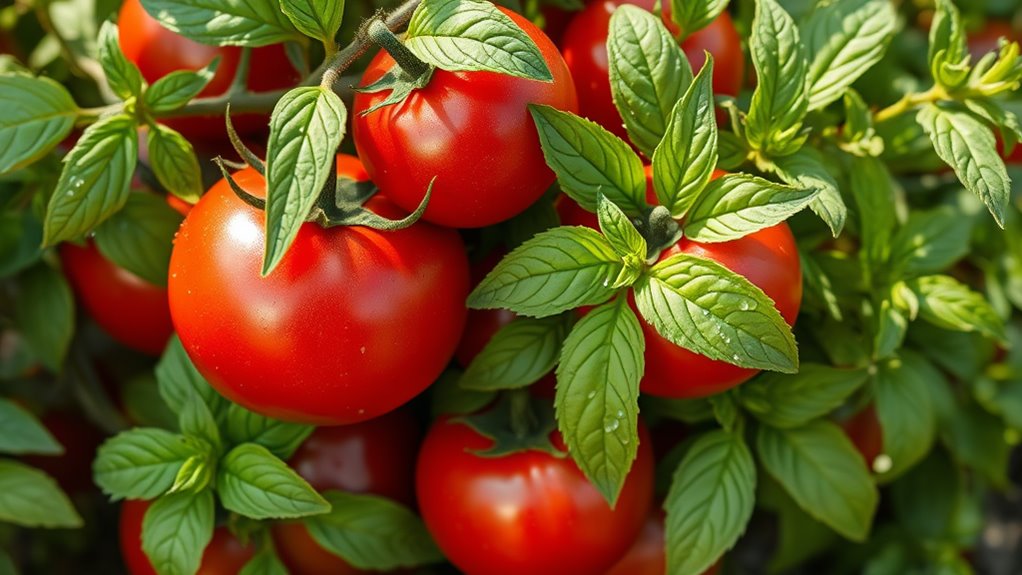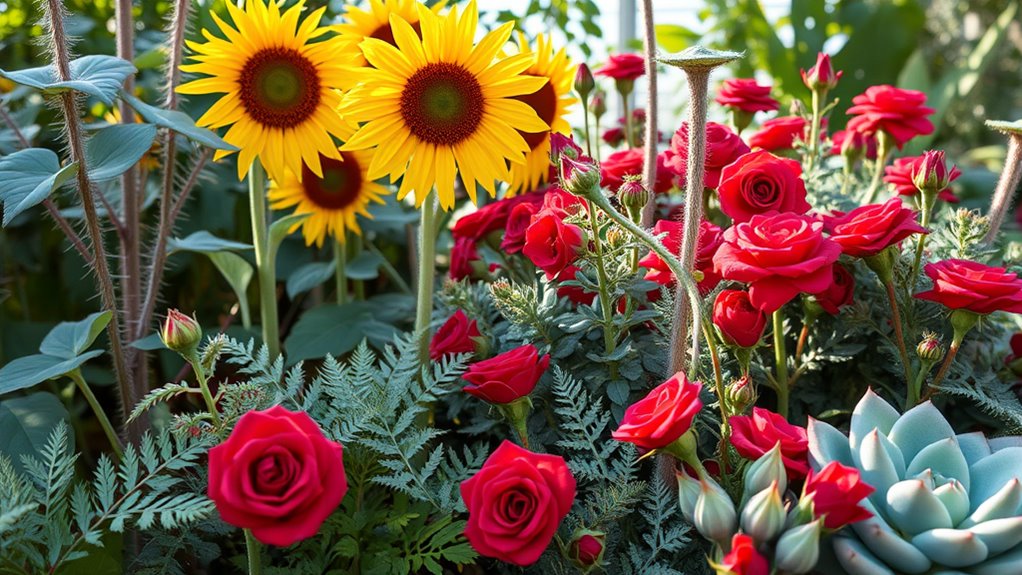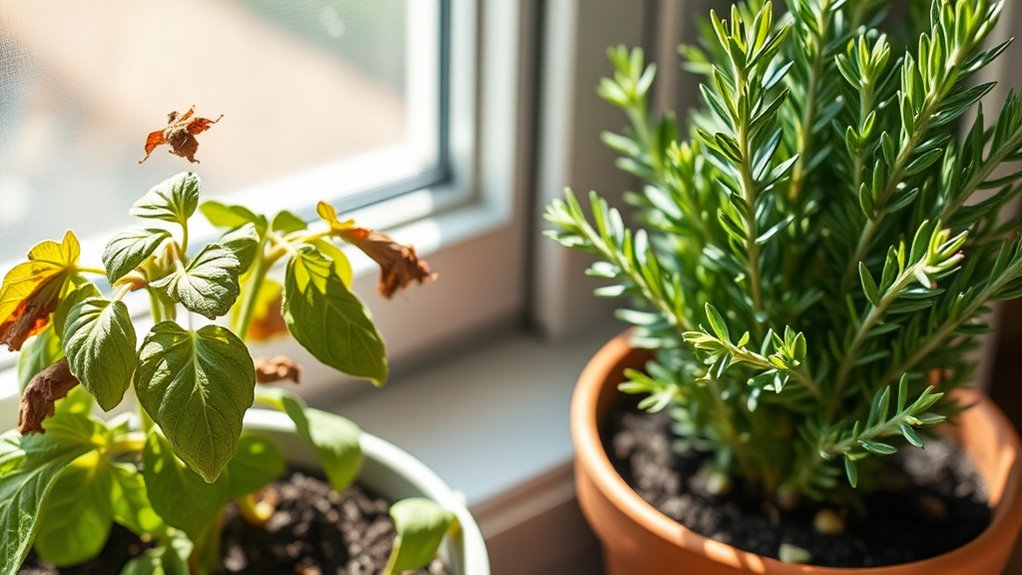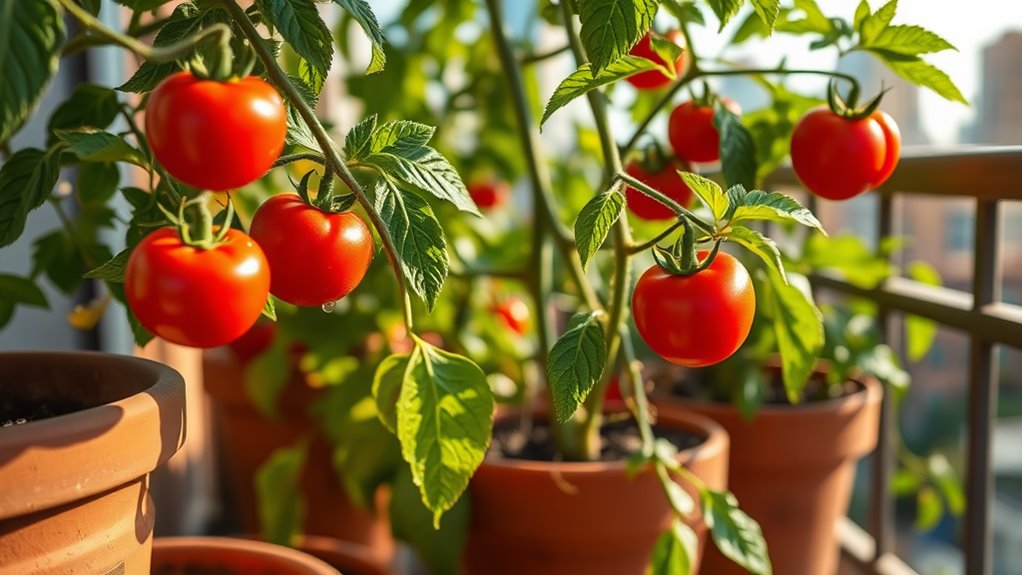The Shocking Results of Planting Basil Near Tomatoes
You’ll be shocked at how planting basil near your tomatoes naturally repels pests like aphids through its aromatic oils, slashing infestations and boosting plant health. You’ll see faster growth as basil enhances soil nutrients and root development, leading to bigger yields and richer flavors in your harvest. Plus, it creates a visually appealing garden with improved long-term soil vitality. Stick around to uncover even more surprising advantages for your setup.
Key Takeaways
- Basil repels pests like aphids from tomatoes, dramatically reducing infestations and chemical needs.
- Planting basil near tomatoes boosts growth by improving soil nutrients and root development.
- This pairing increases tomato yields by attracting pollinators and enhancing fruit production.
- Tomatoes grown with basil develop richer flavors, with amplified sweetness and balanced acidity.
- The combination enhances garden health, promoting a sustainable ecosystem and visual appeal.
Benefits of Companion Planting Basil With Tomatoes
When you plant basil alongside your tomatoes, you’ll harness its natural pest-repelling properties to protect your crop. Furthermore, this combination can enhance growth through improved nutrient uptake in the soil.
Companion plant pairings, like basil with tomatoes, utilize basil’s essential oils to deter pests such as aphids, whiteflies, and hornworms through allelopathy. You’ll reduce infestations by confusing insects with basil’s strong scents, minimizing plant damage.
These pairings also attract beneficial predators like ladybugs, enhancing natural pest control. Practically, interplant basil every 12-18 inches among tomatoes to maximize coverage.
This method promotes a balanced garden ecosystem, cutting chemical use while fostering sustainable practices backed by scientific observations.
In addition, this pairing can enhance flavor, making your tomatoes taste even better in your garden.
How Basil Boosts Tomato Growth
You’ll notice that basil repels pests around your tomatoes, protecting them from common invaders.
It also enhances your tomato plants’ growth by releasing compounds that promote healthier development.
Plus, this setup improves your overall tomato yield, leading to a more productive garden. Additionally, avoiding common mistakes in companion planting can further enhance these benefits for your garden.
This basil and tomato pairing is one of many companion planting strategies that can transform your garden.
Repels Pests
Basil naturally repels pests like aphids and tomato hornworms through its strong aromatic oils, which interfere with the insects’ ability to locate and feed on your tomato plants.
You release these oils by brushing against the leaves, masking the tomatoes’ scent and deterring pests effectively.
Scientifically, basil’s eugenol and linalool compounds disrupt insect communication, reducing infestations naturally.
Plant basil varieties such as Genovese or Thai near your tomatoes to maximize this effect.
It’s a practical, chemical-free strategy that keeps your garden thriving without extra effort.
Regularly trim basil to boost oil production and maintain its pest-repelling power.
Enhances Growth
Beyond repelling pests, companion planting Basil with your tomatoes boosts their growth by fostering a healthier environment.
Basil releases allelopathic compounds that stimulate root development, helping your plants absorb nutrients more efficiently. You’ll notice improved soil aeration as Basil’s roots intermingle, reducing compaction and enhancing water retention.
Scientifically, this synergy increases chlorophyll production, leading to lusher foliage. For practical results, space Basil 12-18 inches from tomatoes; monitor for optimal sunlight.
Improves Yield
One key benefit of pairing Basil with tomatoes is that it markedly increases your yields through enhanced plant health.
By planting basil nearby, you’re naturally repelling pests like aphids and hornworms with its essential oils, reducing crop damage. This allows your tomatoes to focus energy on fruit production rather than defense.
Basil also attracts pollinators such as bees, ensuring more flowers develop into ripe tomatoes. Additionally, it improves soil microbes, enhancing nutrient absorption for larger fruits.
In practice, interplant basil every 12-18 inches around your tomatoes; it’s a simple, science-backed method to boost harvests without chemicals.
Flavor Enhancements From Basil Proximity
You’ve probably noticed how basil influences tomato growth, and now you’ll see how it actively boosts their flavor.
Basil enhances your tomatoes’ taste, making them richer and more vibrant. This proximity also improves the aroma profile, giving you a fresher, more appealing harvest. For instance, this combination exemplifies perfect plant pairs that promote a thriving garden ecosystem.
This is just one of the surprising results from my first experience with companion planting, which can inspire novice gardeners to explore these benefits.
Basil’s Flavor Boost
When you plant basil near your tomatoes, it naturally enhances their flavor through companion planting. Basil releases aromatic oils that repel pests and emit compounds like eugenol, which subtly infuse the air and soil, boosting the tomatoes’ inherent zest and complexity. This creates a synergistic effect, making your harvest more vibrant and enjoyable.
| Flavor Aspect | Enhancement from Basil |
|---|---|
| Sweetness | Increases subtle sweetness via essential oils |
| Acidity | Balances with herbaceous notes |
| Aroma | Adds fresh, peppery undertones |
| Overall Profile | Promotes richer, layered taste |
Tomato Taste Enhancement
Basil’s proximity to tomatoes actively boosts their flavor by releasing compounds like eugenol, which interact with the soil and air to amplify sweetness, balance acidity, and add peppery aromas for a more complex taste.
You can experience this firsthand in your garden; planting basil nearby enhances your tomatoes’ natural sugars, making them taste richer and more balanced.
Scientifically, eugenol’s volatile oils influence root uptake, leading to biochemical changes that reduce tartness.
Practically, you’ll harvest tomatoes with improved mouthfeel and depth, encouraging you to experiment with companion planting for better yields and tastier results.
Aroma Profile Improvement
Beyond enhancing taste, basil’s volatile compounds, such as eugenol, elevate tomatoes’ aroma by emitting peppery and herbal notes that mingle in the air.
You’ll notice this synergy makes your tomato plants release a more complex scent profile, attracting beneficial pollinators while repelling pests like aphids.
Scientifically, basil’s essential oils interact with tomato volatiles, amplifying earthy undertones for a richer garden atmosphere.
Practically, plant basil nearby to boost your harvest’s appeal; you can then enjoy tomatoes with enhanced fragrance in salads or sauces, elevating your culinary experiences effortlessly.
Natural Pest Defense Strategies With Basil
Basil serves as a powerful ally in your garden by repelling pests through its aromatic essential oils. Incorporating such plants aligns with natural ways to keep garden pests at bay using easily accessible staples.
These oils, like eugenol and linalool, release volatile compounds that disrupt pests’ sensory systems, driving away aphids, whiteflies, and spider mites from your tomatoes. You’ll notice fewer infestations as basil’s scent masks the plants’ allure, creating a protective barrier.
Scientifically, this companion planting boosts biodiversity, fostering beneficial insects such as ladybugs.
Practically, it minimizes crop damage and chemical use, letting you harvest healthier yields while maintaining an eco-friendly garden.
This method is one of several unconventional remedies that can be explored for effective natural pest control.
Optimal Planting Techniques for Basil and Tomatoes
To optimize your basil and tomato planting, start by selecting a sunny spot with well-drained soil that maintains a pH between 6.0 and 7.0, as this supports both plants’ growth. Additionally, be cautious of companion planting effects that could influence their compatibility.
Choose disease-resistant varieties for reliable performance. Plant tomatoes after the last frost, burying stems deeply up to the first leaves to foster strong roots.
Space tomato plants 2 feet apart and position basil seeds 1/4 inch deep, thinning seedlings to 12 inches from tomatoes.
Water consistently to keep soil evenly moist, and amend with compost for nutrient boost.
Regularly monitor and adjust soil conditions for peak vitality, ensuring efficient growth without excess intervention.
However, research indicates that basil and tomatoes may negatively affect each other’s growth due to potential interactions in companion planting.
Visual Changes in the Garden From This Pairing
As basil and tomatoes grow side by side, you’ll see their foliage create a lively contrast, with basil’s bright, compact leaves offsetting the tomato plants’ larger, jagged ones for a more textured garden bed.
This pairing enhances visual appeal by introducing varied shades of green; basil’s vibrant hue brightens the scene, while tomatoes add deeper tones as they mature. Such color variations can draw from vibrant flower gardening to create a more dynamic outdoor display.
You’ll notice basil’s bushy form filling gaps, creating a fuller landscape that draws pollinators with its small, white flowers.
Experiment with spacing to maximize this aesthetic, making your garden more inviting and photogenic through strategic plant arrangements.
To further elevate your garden’s professional appearance, incorporate plant selection principles from effective flower bed designs.
Long-Term Garden Impacts of Basil and Tomatoes Together
When you pair basil with tomatoes in your garden, you’ll notice lasting improvements in soil health and pest resistance over multiple seasons.
Basil’s aromatic oils repel insects like aphids and tomato hornworms, minimizing infestations year after year. Its roots enhance microbial activity, boosting nutrient availability and reducing disease risks.
You’ll observe richer soil structure, supporting better water retention and plant vigor. For optimal results, rotate crops annually to prevent soil depletion, ensuring sustained yields and ecosystem balance.
This method promotes a thriving, low-maintenance garden ecosystem.





